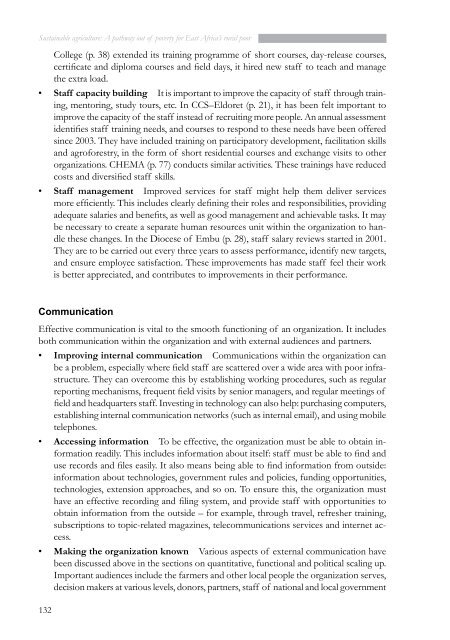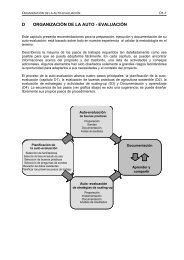cases from tanzania - Sustainet
cases from tanzania - Sustainet
cases from tanzania - Sustainet
Create successful ePaper yourself
Turn your PDF publications into a flip-book with our unique Google optimized e-Paper software.
Sustainable agriculture: A pathway out of poverty for East Africa’s rural poor<br />
132<br />
College (p. 38) extended its training programme of short courses, day-release courses,<br />
certificate and diploma courses and field days, it hired new staff to teach and manage<br />
the extra load.<br />
• Staff capacity building It is important to improve the capacity of staff through training,<br />
mentoring, study tours, etc. In CCS–Eldoret (p. 21), it has been felt important to<br />
improve the capacity of the staff instead of recruiting more people. An annual assessment<br />
identifies staff training needs, and courses to respond to these needs have been offered<br />
since 2003. They have included training on participatory development, facilitation skills<br />
and agroforestry, in the form of short residential courses and exchange visits to other<br />
organizations. CHEMA (p. 77) conducts similar activities. These trainings have reduced<br />
costs and diversified staff skills.<br />
• Staff management Improved services for staff might help them deliver services<br />
more efficiently. This includes clearly defining their roles and responsibilities, providing<br />
adequate salaries and benefits, as well as good management and achievable tasks. It may<br />
be necessary to create a separate human resources unit within the organization to handle<br />
these changes. In the Diocese of Embu (p. 28), staff salary reviews started in 2001.<br />
They are to be carried out every three years to assess performance, identify new targets,<br />
and ensure employee satisfaction. These improvements has made staff feel their work<br />
is better appreciated, and contributes to improvements in their performance.<br />
communication<br />
Effective communication is vital to the smooth functioning of an organization. It includes<br />
both communication within the organization and with external audiences and partners.<br />
• Improving internal communication Communications within the organization can<br />
be a problem, especially where field staff are scattered over a wide area with poor infrastructure.<br />
They can overcome this by establishing working procedures, such as regular<br />
reporting mechanisms, frequent field visits by senior managers, and regular meetings of<br />
field and headquarters staff. Investing in technology can also help: purchasing computers,<br />
establishing internal communication networks (such as internal email), and using mobile<br />
telephones.<br />
• Accessing information To be effective, the organization must be able to obtain information<br />
readily. This includes information about itself: staff must be able to find and<br />
use records and files easily. It also means being able to find information <strong>from</strong> outside:<br />
information about technologies, government rules and policies, funding opportunities,<br />
technologies, extension approaches, and so on. To ensure this, the organization must<br />
have an effective recording and filing system, and provide staff with opportunities to<br />
obtain information <strong>from</strong> the outside – for example, through travel, refresher training,<br />
subscriptions to topic-related magazines, telecommunications services and internet access.<br />
• Making the organization known Various aspects of external communication have<br />
been discussed above in the sections on quantitative, functional and political scaling up.<br />
Important audiences include the farmers and other local people the organization serves,<br />
decision makers at various levels, donors, partners, staff of national and local government




